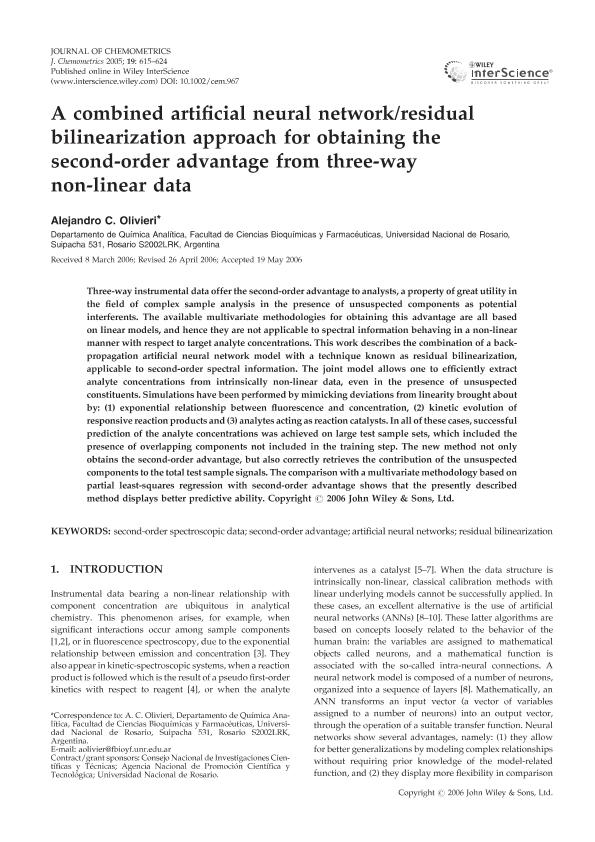Mostrar el registro sencillo del ítem
dc.contributor.author
Olivieri, Alejandro Cesar

dc.date.available
2021-06-28T02:31:21Z
dc.date.issued
2005-11
dc.identifier.citation
Olivieri, Alejandro Cesar; A combined artificial neural network/residual bilinearization approach for obtaining the second-order advantage from three-way non-linear data; John Wiley & Sons Ltd; Journal of Chemometrics; 19; 11-12; 11-2005; 615-624
dc.identifier.issn
0886-9383
dc.identifier.uri
http://hdl.handle.net/11336/134992
dc.description.abstract
Three-way instrumental data offer the second-order advantage to analysts, a property of great utility in the field of complex sample analysis in the presence of unsuspected components as potential interferents. The available multivariate methodologies for obtaining this advantage are all based on linear models, and hence they are not applicable to spectral information behaving in a non-linear manner with respect to target analyte concentrations. This work describes the combination of a back-propagation artificial neural network model with a technique known as residual bilinearization, applicable to second-order spectral information. The joint model allows one to efficiently extract analyte concentrations from intrinsically non-linear data, even in the presence of unsuspected constituents. Simulations have been performed by mimicking deviations from linearity brought about by: (1) exponential relationship between fluorescence and concentration, (2) kinetic evolution of responsive reaction products and (3) analytes acting as reaction catalysts. In all of these cases, successful prediction of the analyte concentrations was achieved on large test sample sets, which included the presence of overlapping components not included in the training step. The new method not only obtains the second-order advantage, but also correctly retrieves the contribution of the unsuspected components to the total test sample signals. The comparison with a multivariate methodology based on partial least-squares regression with second-order advantage shows that the presently described method displays better predictive ability.
dc.format
application/pdf
dc.language.iso
eng
dc.publisher
John Wiley & Sons Ltd

dc.rights
info:eu-repo/semantics/openAccess
dc.rights.uri
https://creativecommons.org/licenses/by-nc-sa/2.5/ar/
dc.subject
ARTIFICIAL NEURAL NETWORKS
dc.subject
RESIDUAL BILINEARIZATION
dc.subject
SECOND-ORDER ADVANTAGE
dc.subject
SECOND-ORDER SPECTROSCOPIC DATA
dc.subject.classification
Química Analítica

dc.subject.classification
Ciencias Químicas

dc.subject.classification
CIENCIAS NATURALES Y EXACTAS

dc.title
A combined artificial neural network/residual bilinearization approach for obtaining the second-order advantage from three-way non-linear data
dc.type
info:eu-repo/semantics/article
dc.type
info:ar-repo/semantics/artículo
dc.type
info:eu-repo/semantics/publishedVersion
dc.date.updated
2021-06-07T16:16:31Z
dc.journal.volume
19
dc.journal.number
11-12
dc.journal.pagination
615-624
dc.journal.pais
Reino Unido

dc.journal.ciudad
Londres
dc.description.fil
Fil: Olivieri, Alejandro Cesar. Consejo Nacional de Investigaciones Científicas y Técnicas. Centro Científico Tecnológico Conicet - Rosario. Instituto de Química Rosario. Universidad Nacional de Rosario. Facultad de Ciencias Bioquímicas y Farmacéuticas. Instituto de Química Rosario; Argentina. Universidad Nacional de Rosario. Facultad de Ciencias Bioquímicas y Farmacéuticas. Departamento de Química Analítica; Argentina
dc.journal.title
Journal of Chemometrics

dc.relation.alternativeid
info:eu-repo/semantics/altIdentifier/url/https://analyticalsciencejournals.onlinelibrary.wiley.com/doi/abs/10.1002/cem.967
dc.relation.alternativeid
info:eu-repo/semantics/altIdentifier/doi/http://dx.doi.org/10.1002/cem.967
Archivos asociados
